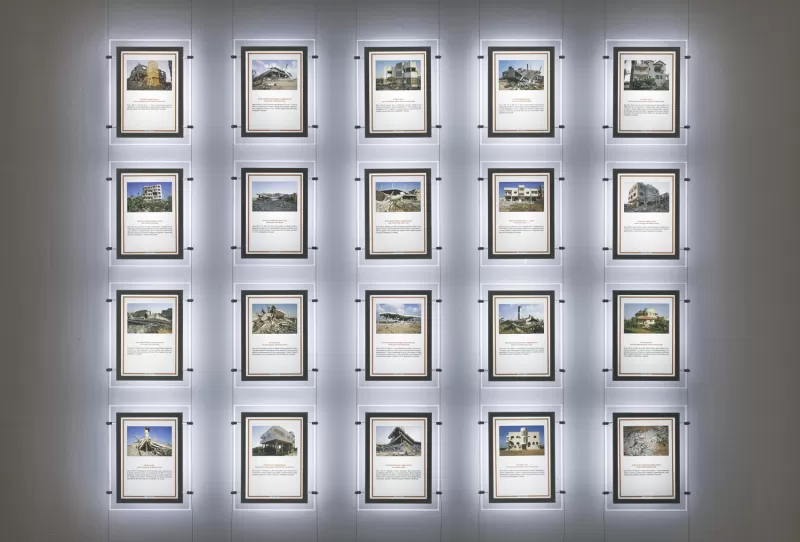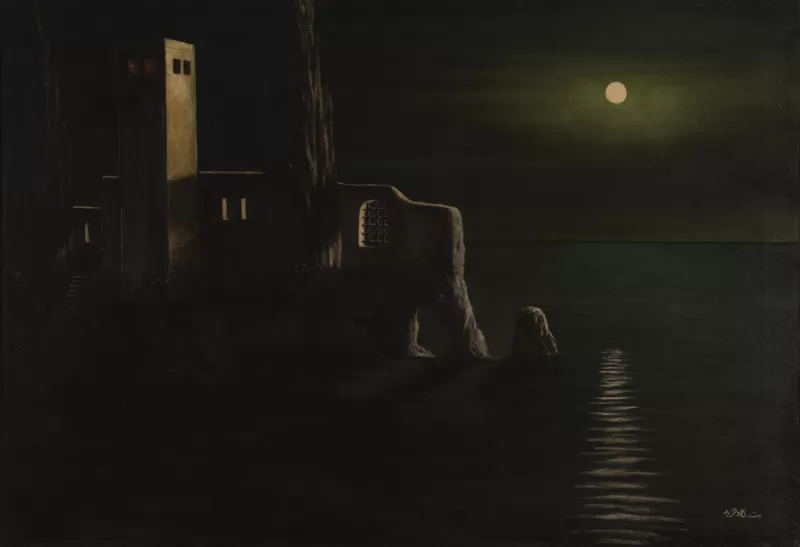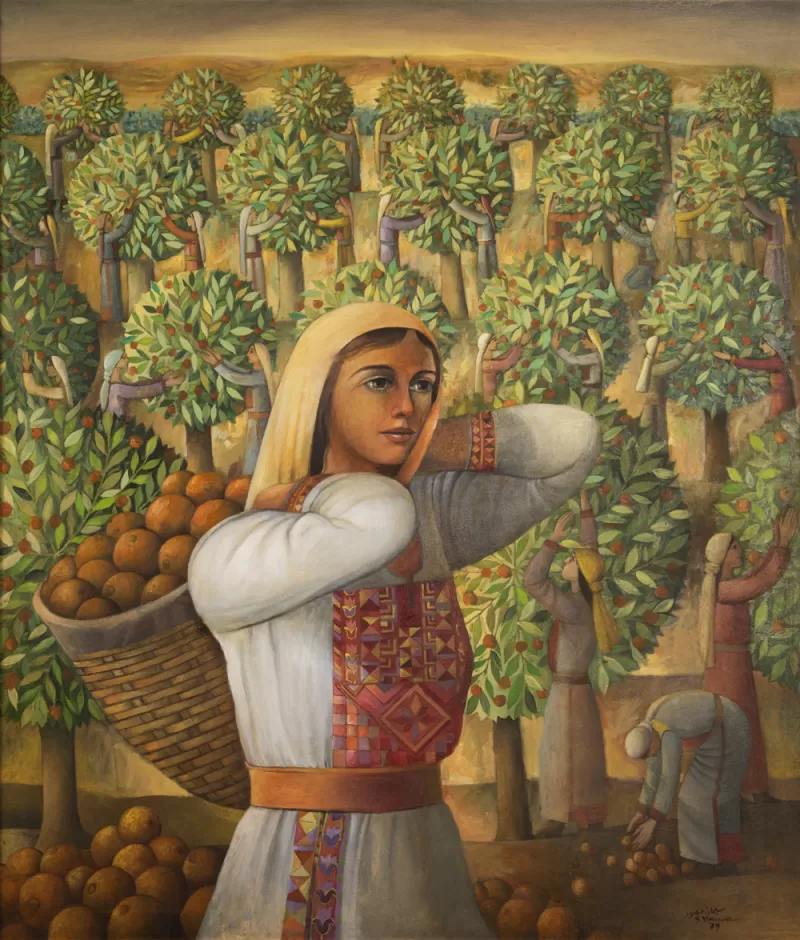Coinciding with the 43rd anniversary of Land Day, the Palestinian Museum opens its new art exhibition “Intimate Terrains: Representations of a Disappearing Landscape”, on April 2nd, 2019. The exhibition, by guest curator Dr. Tina Sherwell, will run until December 31st, 2019.
Intimate Terrains explores the changing representations of landscape by Palestinian artists and our relationship to place and location. Landscape has been a prominent subject matter in Palestinian art as a deeply layered terrain of inscriptions, memories and histories, which holds a central place in Palestinian identity formation.
Via a selection of iconic works by 36 artists from Palestine and its diaspora, the exhibition explores how the changing reality on the ground contoured representations of landscape from the 1930s to the present day. The 87 works encompass painting, photography, installation, video and film, natural media, and sculpture. Intimate Terrains asks: what ties us to places? What keeps us in a place? What have been and what are our and dreams and visions of landscapes of the past and future?
The exhibition presents how loss and the ongoing transformations of the landscape contour representations along with addressing questions about exile and the experiences of distance from the homeland. How do artists negotiate collective and personal memory in relation to landscape? How does the changing reality on the ground contour their images?
Representation of the landscape has a long history in Palestine and is an integral part of its cultural practices. In this exhibition, visitors will explore changes in representation after years of political, social and ecological transformations. For example, in Tawfiq Jawharieh’s Untitled, created c1930, the artist proposes a surreal Palestinian landscape, leaving us to wonder, could this be Palestine? Serene lake, classical architecture, a moonlit landscape of picturesque Cypress trees. These contemplative scenes underline landscape as a space of imaginings and fantasy, pointing to how audiences’ visions and dreams were molded by artists.
Landscapes came to dominate Palestinian art in the mid-1970s and 1980s. This was accompanied by calls to resistance through popular posters filled with folkloric motifs. Prior, artists had generally focused on representing experiences of suffering of exile. Yaffa, 1979 by Sliman Mansour is one such example of how the focus on the village and peasantry represented Palestinian landscape as a domestic one wherein peasant women constitute the central subject. This painting is one of many in this vein created by Mansour and his peers. The presence of female figures in the landscape in traditional costumes became then the foremost signifier of Palestinian national identity. As in many nationalist struggles’ representational contexts, a woman’s body is often metonymic of the land/homeland.
In contemporary artworks, landscape becomes something to be viewed and remembered, as new policies distancing Palestinians from their land are dictated daily by the Israeli occupation. Taysir Batniji created GH809#2 (Gaza houses 2008-2009) after the war on Gaza in 2009. As Batniji was unable to return home because of the blockade of the Gaza Strip, he recruited journalist Sami al-Ajrami to document houses damaged by Israeli bombardments. Photographs of each home are displayed in the form of real estate ads with detailed neutral description of specifications of each house. The aim of the artist was to commit these sites to memory through this form of testimony which can also be read as a type of archaeological record of historic ruins. Through this choice of represenation, Batniji addresses the depersonalization of bombed sites, as well as the paradoxes of war and occupation, in which market sales for concrete, land, and real estate flourish and crash.
In the glass gallery, adjacent to our exhibition hall, is displayed a selection of leaflets, wall texts, poems, infographics, timelines and legal documents covering the themes of loss, erasure, fragmentation and resistance, which map and highlight the historical and political structuring conditions that transformed landscape and art into what they are today.
Accompanying the exhibition is a Public and Education program organized around monthly themes related to the exhibition addressing questions of ecology, archaeology, spatial politics, historicization and literature and more, via artist talks, workshops, performances, interactive tours, film screenings, panel discussions and lectures.
The Museum is also publishing an exhibition catalogue featuring a curatorial text by Dr. Tina Sherwell, artists’ statements, as well as images of all their artworks. The catalogue will be available for purchase at the Museum’s gift shop by June 2019.
The Palestinian Museum extends its thanks to the participating artists: Jumana Emil Abboud, Tarek Al-Ghoussein, Jawad Almalhi, Basma Alsharif, Nabil Anani, Johnny Andonia, Rafat Asad, Asad Azi, Samira Badran, Tayseer Barakat, Taysir Batniji, Rana Bishara, Benji Boyadgian, Hassan Daraghmeh, Aissa Deebi, Sophie Halaby, Samia Halaby, Rula Halawani, Hazem Harb, Tawfiq Jawharieh, Yazan Khalili, Manal Mahamid, Bashir Makhoul, Sliman Mansour, Jack Persekian, Khalil Rayan, Steve Sabella, Larissa Sansour, Walid Abu Shakra, Laila Shawa, Amer Shomali, Suha Shoman, Nida Sinnokrot, Nasser Soumi, Vera Tamari, Vladimir Tamari.
The Palestinian Museum also thanks its lenders and sponsors: Yvette and Mazen Qupty Collection, George Al Ama, Bank of Palestine, Birzeit University Museum, VCU School of the Arts, Galerie Imane Farès, Sfeir-Semler Gallery, Ayyam Gallery, Tabari Artspace, The Third Line Gallery- Dubai, Zawyeh Gallery, Vladimir Tamari’s family, The Linbury Trust.
Dr. Tina Sherwell is an art historian and curator; she was director of The International Academy of Art, Palestine, a post she has held between 2007–12 and 2013–17. Previously she was Programme Leader of Fine Art at Winchester School of Art (2005–2007). She won a prize at the Alexandria Biennale in 2001 for her map series of Palestine. She is the author of various texts on Palestinian art and visual culture.
The Palestinian Museum is an independent institution dedicated to supporting an open and dynamic Palestinian culture nationally and internationally. The Museum presents and engages with new perspectives on Palestinian history, society and culture. The Museum is a flagship project of Taawon (Welfare Association), an independent Palestinian non-profit organization, committed to providing development and humanitarian assistance in Palestine and the Palestinian communities in Lebanon.


